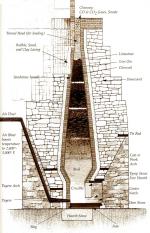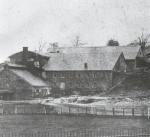![header=[Marker Text] body=[Built by Peter Grubb. Operated from 1742 to 1883.] sign](http://explorepahistory.com/kora/files/1/10/1-A-2AE-139-ExplorePAHistory-a0k1t7-a_450.jpg)
Mouse over for marker text
Name:
Cornwall Furnace
Region:
Hershey/Gettysburg/Dutch Country Region
County:
Lebanon
Marker Location:
Rexmont Road at site
Dedication Date:
August 1948
Behind the Marker
One of the most important iron producers in colonial Pennsylvania, Cornwall Furnace operated under the ownership of the Grubb and Coleman families from 1742 until the furnace's closure in 1883. In the twentieth century, the Colemans and the Commonwealth of Pennsylvania preserved Cornwall Furnace, which survives today as an outstanding example of a nineteenth century American charcoal iron furnace.
A leading colonial ironmaster, Peter Grubb began first venture into the iron industry with a bloomery forge, which he opened in 1737 in present-day Lebanon County. During the 1730s Grubb acquired thousands of acres of land, including the iron ore deposits of Cornwall Banks. On this land in 1742, Grubb constructed his first iron furnace, which he named it after Cornwall, his father's home county in England. In 1745 he leased the furnace to a group of Quaker entrepreneurs who produced pig iron and cast iron products, principally stoves.
Cornwall Banks. On this land in 1742, Grubb constructed his first iron furnace, which he named it after Cornwall, his father's home county in England. In 1745 he leased the furnace to a group of Quaker entrepreneurs who produced pig iron and cast iron products, principally stoves.
When Grubb died in 1754, the furnace and ore banks went to his sons Curttis and Peter, Jr., who continued pig iron and stove production. Steadfast supporters of American independence, the brothers both became colonels in the Continental Army. On August 25, 1776, less than twop months after the signing of the Declaration of Independence, Cornwall Furnace cast its first cannon; by January 1777 the furnace had cast two dozen cannons for Continental forces. During the Revolutionary War, Cornwall Furnace was an important manufacturer of cannon, shot, and salt pans (used to produce salt) for the patriot cause.
Like other Pennsylvania iron works, Cornwall Furnace employed a mix of free men, indentured servants, and slaves. With free men in short supply as men went off to war, and indentured servants unreliable, the Grubbs manned the furnace with Hessian prisoners captured during the war, and increased their reliance upon slaves, who grew in number from five in 1776 to sixteen in 1786. By 1780 Curtiss Grub was the largest slaveowner in Lebanon and Lancaster County. After passage of the Pennsylvania gradual emancipation act in 1780 and the end of the war three years later, the Grubbs and Robert Coleman, the subsequent furnace owner, slowly ended their use of slaves. The process was so gradual, however, that Robert Coleman owned slave ironworkers as late as 1821.
Robert Coleman owned Cornwall Furnace and a five-sixths interest in the Cornwall Banks by 1798. He and successive generations of his family built an empire of iron furnaces and forges in Pennsylvania. Paternalistic owners, the Colemans constructed frame houses for workers--which joined the stone houses that the Grubbs had built previously-- a church, and schools for workers' children. They paid workers' medical bills and the salaries of the school teachers. During the mid-1800s, each Christmas they gave a large turkey to each of the almost 500 workers they employed, and invited workers and their families to their lavish mansion, where they distributed toys to the children.
The paternalism of the Colemans and deference of the iron workers and their families lasted for generations. In the late 1930s, well after the Colemans had sold out to the Pennsylvania Steel Company, the class divisions remained. Remembering the time when a Coleman hunting party had accidentally fired upon some Cornwall workers, a worker reflected that "It never entered our heads to complain about their endangering our lives. We were peasants. They were nobles!"
Unable to compete with newer anthracite coal furnaces, the Colemans closed Cornwall Furnace in 1883. The family, however, continued to own and preserve much of the idle works.In 1932 Margaret Coleman Freeman Buckingham, the great-granddaughter of Robert Coleman, presented Cornwall Iron Furnace to the Commonwealth of Pennsylvania, which restored the surviving buildings, including the furnace, connecting shed, roasting oven, coal bins, blacksmith shop, wagon shop, and slaughter house.
Today, the Cornwall Iron Furnace is an historic sie and museum operated by the Pennsylvania Historical and Museum Commission. Also preserved nearby, but not open to the public, are the palatial stable, manager's house and mine office, Cornwall Bank open-pit mine, office building, and ironmaster's mansion. Now part of a National Historic Landmark District, Cornwall Furnace survives as the most fully intact and best preserved example of a nineteenth century American charcoal furnace.
A leading colonial ironmaster, Peter Grubb began first venture into the iron industry with a bloomery forge, which he opened in 1737 in present-day Lebanon County. During the 1730s Grubb acquired thousands of acres of land, including the iron ore deposits of
When Grubb died in 1754, the furnace and ore banks went to his sons Curttis and Peter, Jr., who continued pig iron and stove production. Steadfast supporters of American independence, the brothers both became colonels in the Continental Army. On August 25, 1776, less than twop months after the signing of the Declaration of Independence, Cornwall Furnace cast its first cannon; by January 1777 the furnace had cast two dozen cannons for Continental forces. During the Revolutionary War, Cornwall Furnace was an important manufacturer of cannon, shot, and salt pans (used to produce salt) for the patriot cause.
Like other Pennsylvania iron works, Cornwall Furnace employed a mix of free men, indentured servants, and slaves. With free men in short supply as men went off to war, and indentured servants unreliable, the Grubbs manned the furnace with Hessian prisoners captured during the war, and increased their reliance upon slaves, who grew in number from five in 1776 to sixteen in 1786. By 1780 Curtiss Grub was the largest slaveowner in Lebanon and Lancaster County. After passage of the Pennsylvania gradual emancipation act in 1780 and the end of the war three years later, the Grubbs and Robert Coleman, the subsequent furnace owner, slowly ended their use of slaves. The process was so gradual, however, that Robert Coleman owned slave ironworkers as late as 1821.
Robert Coleman owned Cornwall Furnace and a five-sixths interest in the Cornwall Banks by 1798. He and successive generations of his family built an empire of iron furnaces and forges in Pennsylvania. Paternalistic owners, the Colemans constructed frame houses for workers--which joined the stone houses that the Grubbs had built previously-- a church, and schools for workers' children. They paid workers' medical bills and the salaries of the school teachers. During the mid-1800s, each Christmas they gave a large turkey to each of the almost 500 workers they employed, and invited workers and their families to their lavish mansion, where they distributed toys to the children.
The paternalism of the Colemans and deference of the iron workers and their families lasted for generations. In the late 1930s, well after the Colemans had sold out to the Pennsylvania Steel Company, the class divisions remained. Remembering the time when a Coleman hunting party had accidentally fired upon some Cornwall workers, a worker reflected that "It never entered our heads to complain about their endangering our lives. We were peasants. They were nobles!"
Unable to compete with newer anthracite coal furnaces, the Colemans closed Cornwall Furnace in 1883. The family, however, continued to own and preserve much of the idle works.In 1932 Margaret Coleman Freeman Buckingham, the great-granddaughter of Robert Coleman, presented Cornwall Iron Furnace to the Commonwealth of Pennsylvania, which restored the surviving buildings, including the furnace, connecting shed, roasting oven, coal bins, blacksmith shop, wagon shop, and slaughter house.
Today, the Cornwall Iron Furnace is an historic sie and museum operated by the Pennsylvania Historical and Museum Commission. Also preserved nearby, but not open to the public, are the palatial stable, manager's house and mine office, Cornwall Bank open-pit mine, office building, and ironmaster's mansion. Now part of a National Historic Landmark District, Cornwall Furnace survives as the most fully intact and best preserved example of a nineteenth century American charcoal furnace.
Beyond the Marker









